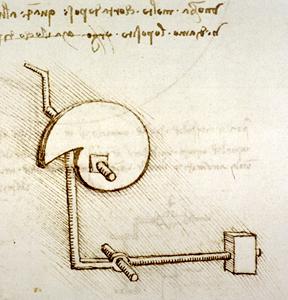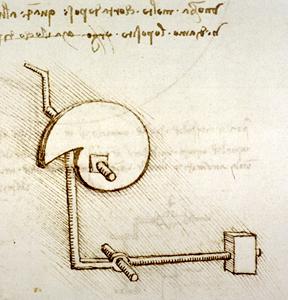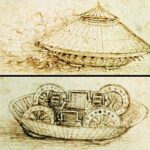Leonardo da Vinci Cam Hammer

Leonardo da Vinci’s cam hammer
The da Vinci Cam Hammer is a fascinating machine highlighting Leonardo da Vinci‘s incredible foresight and ingenuity.
This invention revolutionized mechanical tools. It was used for centuries, especially during the Industrial Revolution.
By exploring the design and impact of the cam hammer, one can appreciate its lasting influence on engineering.
This article provides an in-depth look at how Leonardo’s design works and its historical significance for those intrigued by mechanical history and innovation.
You will discover how this invention showcases the connection between art, science, and technology.
Through this exploration, enthusiasts can learn about the cam hammer’s notable features, including its reliance on a rotating cam to lift and drop a hammer.
Those interested in machinery’s practical applications and evolution will find da Vinci Cam Hammer’s story informative and engaging.
Leonardo da Vinci: The Inventor
Leonardo da Vinci was a pioneer during the Renaissance known for his incredible ingenuity. His contributions to the industrial and artistic realms are well-recognized, notably the development of innovative machinery such as the da Vinci Cam Hammer.
Renaissance Context
During the Renaissance, between the 14th and 17th centuries, there was a surge of interest in art, science, and technology. This era encouraged creativity and sparked numerous intellectual advancements.
Da Vinci thrived in this environment, seamlessly blending art and science. He explored various fields, pushing boundaries and creating designs ahead of his time.
His dual role as an artist and engineer allowed him to conceive novel inventions significantly impacting various industries.
Inventions and Machinery
Leonardo’s fascination with machinery led to creating devices like the cam hammer. This invention used a rotating cam to lift and drop a hammer repeatedly, making metalworking more efficient.
His drawings showcased an advanced understanding of mechanical principles, which modern engineers find inspiring.
The da Vinci Power Hammer exemplifies his innovative spirit, illustrating his ability to merge artistic flair with engineering expertise.
The Cam Hammer Concept
The da Vinci Cam Hammer represents a unique blend of innovation and mechanical ingenuity. It introduces a cam-driven mechanism that has had significant impacts on fields like metalworking and engineering.
Mechanical Design
Leonardo da Vinci’s Cam Hammer features a design ahead of its time. This ingenious creation utilizes a cam to convert rotational motion into a linear pounding action.
The cam, an oblong wheel, pushes a hammerhead upwards while gravity pulls it back down, creating a rhythmic pounding effect.
This simple yet effective mechanism allows the hammer to perform work with minimal energy input.
Unlike direct contact mechanisms, the cam design reduces wear and tear, ensuring longer life and less maintenance.
Leonardo’s insight into mechanical advantage laid the groundwork for future advancements and influenced designs used during the Industrial Revolution.
The cam hammer can be seen as a precursor to modern automated machinery.
Function and Efficiency
The da Vinci Cam Hammer offered significant improvements in efficiency over traditional hand tools.
During the Industrial Revolution, these hammers could achieve up to twenty strikes per second using gravity combined with the mechanical lifting action of the cam.
This level of speed was instrumental in shaping and forming metal quickly and precisely.
The increased hammering rate allowed for higher productivity in workshops and the fabrication of intricate metal components, such as sheet metal and armored machines.
Despite its historical context, the da Vinci power hammer concept highlighted the potential of mechanized labor, reducing manual effort and increasing output.
Historical Significance
The da Vinci Cam Hammer marks a pivotal moment in the development of machinery. It played a key role in metalworking and engineering fields. Below, we explore how this invention advanced metalwork and influenced engineering practices.
Advancements in Metalworking
The da Vinci power hammer advanced metalworking by introducing automation in the forging process. This innovation allowed metalworkers to handle larger quantities of metal efficiently.
Leonardo da Vinci’s design used a cam mechanism that enabled continuous hammering without manual effort.
This reduced the physical labor needed in metalworking shops and improved precision in creating metal tools and components.
The cam hammer was a precursor to more advanced machinery, paving the way for the Industrial Revolution.
Blacksmiths could achieve consistent results, which is crucial for creating uniform metal goods.
It was a transformative step in automating tasks traditionally dependent on human strength and skill.
Impact on Engineering
Leonardo da Vinci’s cam hammer significantly impacted engineering by showcasing how mechanical systems could replace manual labor.
The design leveraged physics principles to automate repetitive tasks, demonstrating early ideas of mechanization.
This influenced future inventors and engineers to explore similar concepts in various fields.
Da Vinci’s work on the cam hammer laid foundational ideas that inspired the creation of complex machines.
Engineers began to appreciate the efficiency of automated processes, considering them in their designs.
The cam mechanism, in particular, highlighted the potential for gears and levers in machinery, which became core elements in engineering design.
These principles are evident in modern systems, showing the enduring legacy of da Vinci’s innovative engineering.
Modern Interpretations
The da Vinci Cam Hammer continues to fascinate enthusiasts and historians alike. This section explores how modern technology and historical curiosity intersect in replicating and understanding the cam hammer’s unique design and purpose.
Replications and Models
Enthusiasts and engineers worldwide have attempted to recreate the da Vinci Cam Hammer, testing its functionality with today’s materials and technology.
These models often involve careful study of Leonardo da Vinci’s original sketches, integrating modern engineering tools for precision.
By placing the cam mechanism correctly and maintaining balance, creators aim to understand and showcase the hammer’s mechanical brilliance.
Many hobbyists and professionals share their builds and experiments online, offering insights into the challenges and successes of these projects.
The availability of resources like 3D printing and CNC machining has made it possible to create accurate models, pushing forward the hands-on study of da Vinci’s innovative ideas.
Educational Value
The da Vinci Power Hammer serves an educational purpose beyond mere replication. It allows students and history buffs to delve into Renaissance engineering concepts.
Through these projects, learners can explore basic mechanics, such as the impact of cams and pulleys, bringing historical theories into a tangible form.
Museums and educational platforms often utilize the cam hammer design to illustrate the foundation of modern machinery.
By studying these interpretations, individuals better appreciate how past innovations inform present technologies.
Interactive demonstrations can further enrich educational experiences, making the complex concepts behind the hammer both approachable and engaging.
Technical Analysis
Da Vinci’s Cam Hammer is a striking example of innovative engineering, combining mechanical ingenuity with practical applications. It employs a system where materials and construction are critical and utilizes kinetic principles to drive the hammer mechanism efficiently.
Materials and Construction
The Da Vinci Cam Hammer typically uses robust materials to withstand repetitive motion. Materials like wood and metal were chosen for their strength and durability in the original designs.
These materials ensure long-lasting functionality.
The cam mechanism was often crafted from dense wood or forged metal, allowing it to resist wear and maintain precision.
A wooden or metal frame provides stability while the moving parts are securely attached.
The hammer itself is usually a large block of metal, frequently fashioned from iron or steel, which provides the necessary weight to generate impact force.
The choice of materials dramatically affects the machine’s performance and longevity, with quality construction being critical in ensuring that components work together seamlessly.
Kinetic Principles
The primary function of the Da Vinci Power Hammer relies on kinetic principles where a rotating cam lifts the hammer and then releases it to strike with force.
This rotational movement transforms into linear motion.
The cam’s design is pivotal—it must be shaped correctly to transfer energy from the rotation to the hammer efficiently.
The da Vinci hammer converts potential energy into kinetic energy by elevating and suddenly dropping it.
The precision of the cam’s shape and the balance of the mechanical components are essential.
These principles allow for continuous and rapid striking, which is crucial for applications in metalworking and forging.
Correctly harnessing these principles enables effective use and maximizes the power of each strike.
Frequently Asked Questions
The da Vinci Cam Hammer is an innovative device created by Leonardo da Vinci. It features a rotating cam mechanism that lifts and drops a hammer. This invention has intrigued many due to its historical significance and engineering design.
What are the main components of a cam hammer, and how do they function?
A cam hammer consists of a cam, a hammer, and a lifting mechanism. The cam rotates to lift the hammer, then forcefully drops onto the workpiece. This repeating action makes metalworking more efficient by increasing the number of impacts per minute.
Where can one find plans for constructing a power hammer?
Plans for building a power hammer can be found on various educational websites and engineering forums, such as How to Make Everything. These resources often provide detailed guides and diagrams.
What are the key differences between a treadle hammer and a cam hammer?
A treadle hammer is manually operated using a foot pedal, while a cam hammer uses a cam mechanism for automation. The cam system allows for faster and more consistent impacts, making it better suited for industrial applications.
How can one maintain and service a power hammer to ensure its longevity?
To maintain a power hammer, it is important to regularly inspect for wear and lubricate moving parts. Checking for loose bolts and ensuring the cam mechanism is adequately aligned can help prevent breakdowns and extend the machine’s lifespan.
What safety precautions should be taken when operating a cam hammer?
Operators should wear safety goggles and gloves to protect against flying debris and vibrations. They should also keep a safe distance from the moving parts and be aware of emergency shut-off procedures to prevent accidents.
Can a power hammer be effectively used for DIY metalworking projects?
Yes, a power hammer can be pretty practical for DIY metalworking projects. Hobbyists can use them for forging and shaping metal. Adjustments can be made for smaller-scale operations to suit individual project needs.

 I’m Leonardo Bianchi, the mind behind Leonardo da Vinci's Inventions. Thanks for visiting.
I’m Leonardo Bianchi, the mind behind Leonardo da Vinci's Inventions. Thanks for visiting. 


